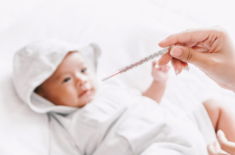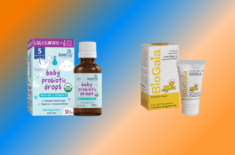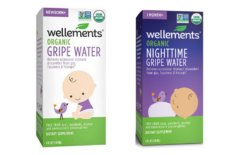Are Vitamin D Drops Necessary For Babies?
Yes. Babies need vitamin D for bone health, skeletal growth, general wellness, and a healthier immune system.
It’s an essential nutrient for their development and also helps their body absorb calcium more efficiently. (1)
If the amount of vitamin D is lower than what your child’s body needs, it could lead to nutritional rickets. This condition can cause soft bones.
Although sun exposure naturally increases vitamin D levels, it isn’t advisable for babies due to the harmful effects of UV (ultraviolet rays). The AAP recommends minimal sunlight exposure through sunscreen and protective clothing to avoid sunburn. (2)
So, supplementation with baby vitamin D drops can be better than direct sun exposure.
Supplementation with cholecalciferol (vitamin D3) is preferred over ergocalciferol (vitamin D2). Vitamin D3 is more potent than vitamin D2, stays in the bloodstream longer, and helps maximize absorption. (2)(3)
Daily Recommendation: How Much Vitamin D Do Babies Need?
Studies show that a mom’s vitamin D status during pregnancy can have long-term effects on her baby. So, healthcare professionals usually advise prenatal vitamin D supplementation. (2)
Babies born to vitamin D-deficient moms are more likely to become vitamin D-deficient than those born to moms who supplemented with vitamin D during pregnancy. (2)
But it’s not too late to catch up, mama.
The American Academy of Pediatrics (AAP) recommends the following vitamin D supplements for babies younger than one year of age: (2)(4)
- 400 IU for exclusively or partially breastfed babies
- 400 IU (in 1 liter or 34 oz of formula per day)* for formula-fed babies
*Formulas sold in the US must have at least 400 IU of vitamin D per liter. (2)
The AAP also recommends supplementing infants with vitamin D if they aren’t drinking at least 34 oz of formula a day. Talk to your pediatrician for the right dose. (4)
Even if you’re taking vitamin D while breastfeeding, following the AAP’s recommendations for infants is important. Studies show that breastfed infants might not receive enough vitamin D even from moms with adequate stores or supplementing with the vitamin. (2)(4)
Our Top 5 Baby Vitamin D Drops
- Gerber Good Start Soothe Vitamin D and Probiotic Drops, one bottle (0.34 fl oz) – Contains probiotics and is clinically proven to reduce the crying time from colic and reduce spit-up frequency
- Baby Ddrops Daily Vitamin D for Infants, one bottle (0.08 fl oz) – USDA-certified organic (U.S. Department of Agriculture), Non-GMO Project Verified, and NSF certified (National Sanitation Foundation)
- Nordic Naturals Baby’s Vitamin D3, one bottle (0.37 fl oz) – Non-GMO Verified vegetarian vitamin D3 drops
- Mommy’s Bliss Baby Vitamin D Organic Drops, one bottle (0.11 fl oz) – USDA-certified organic vitamin in a squeeze bottle, and free from the top 8 allergens
- Carlson’s Baby’s Super Daily D3, one bottle (365 drops) – Vegetarian supplement available in a bottle with 365 drops (good for one year)
Continue reading to learn more about each baby vitamin D drops below.
Gerber Good Start Soothe Vitamin D and Probiotic Drops



What Makes It Special?
- Baby vitamin D drops with probiotics
- Non-GMO (genetically modified organisms)
- Contains the probiotic L. reuteri DSM 17938, similar to those naturally found in breast milk
- The brand claims that this product is clinically shown to help balance an infant’s microbiota, reduce crying time by 50% in just one week, and reduce the frequency of spit-ups by 50% in two weeks.
Key Features
- Vitamin D Content: 400 IU
- Ingredients: Vitamin D (as cholecalciferol), Lactobacillus reuteri Portectis (DSM 17938), medium-chain triglyceride oil, sunflower oil, and silicon dioxide
- Dosage: Five drops total per day
- How It’s Administered: Add five drops to formula or breast milk or spread out the five drops throughout the day
- Safety Features: Free from GMOs
- Third-party Testing: Not indicated
Product Recall
- None
Cons
- Some parents complained that this product made their babies fussier or have pooping issues.
Brand’s Other Vitamin D Products For Kids
Baby Ddrops Daily Vitamin D For Infants



What Makes It Special?
- One drop meets the AAP’s daily vitamin D recommendations (400 IU) for babies
- USDA-certified organic (U.S. Department of Agriculture)
- A tasteless, odorless dietary supplement to avoid interfering with feeding
- Contains fractionated coconut oil
Key Features
- Vitamin D Content: 400 IU
- Ingredients: Vitamin D3 (cholecalciferol) and fractionated coconut oil
- Dosage: One drop per day
- How It’s Administered: Use the bubble-style dropper to add one drop to your baby’s milk or put it on a clean surface (such as a washed fingertip or nipple before breastfeeding)
- Safety Features: Free from additives, artificial flavors, preservatives, colors, and common allergens
- Third-party Testing: USDA-certified organic, Non-GMO Project Verified, and NSF certified (National Sanitation Foundation)
Product Recall
- None
Cons
- Some parents complained that this product made their baby gassy.
Brand’s Other Vitamin D Products
- Kids Ddrops Booster 600 IU 100 Drops for one year old and older, one bottle (0.09 fl oz)
- Vegan Ddrops D2, one bottle (0.17 fl oz)
- Ddrops 1000 IU for adults, one bottle (0.17 fl oz)
- Ddrops 2000 IU for adults, one bottle (0.17 fl oz)
Mommy’s Bliss Baby Vitamin D Organic Drops



What Makes It Special?
- USDA-certified organic
- 400 IU of vitamin D per drop
- Squeeze bottle instead of a rigid bottle with a dropper
Key Features
- Vitamin D Content: 400 IU
- Ingredients: Vitamin D3 and organic MCT (medium-chain triglyceride) oil
- Dosage: One drop per day
- How It’s Administered: Place directly on your nipple or add to breastmilk, infant formula, or baby food
- Safety Features: Free from added sugars, gluten, dairy, binders and fillers, yeast, dill, alcohol, petroleum-based by-products, artificials colors or flavors, and top 8 allergens*
- Third-party Testing: USDA and NSF certified
*The top 8 allergens:
- Milk
- Eggs
- Fish
- Crustacean shellfish
- Tree nuts
- Peanuts
- Wheat
- Soybeans
Product Recall
- None
Cons
- Some complaints about the product being difficult to get from the bottle and making babies feel fussier or have green poop
Brand’s Other Vitamin D Products For Kids
- Newborn essentials gift set (includes vitamin D drops, gripe water, nasal drops, and gas relief drops)
Nordic Naturals Baby’s Vitamin D3
What Makes It Special?
- One drop has 400 IU of vitamin D
- Non-GMO Verified
- Made with organic extra virgin olive oil
- Third-party purity tested
- Vegetarian vitamin D3 drops
Key Features
- Vitamin D Content: 400 IU
- Ingredients: Vitamin D3 (cholecalciferol) and organic extra virgin olive oil
- Dosage: One drop per day
- How It’s Administered:
- Safety Features: Free from milk derivatives, gluten, or artificial colors or flavors
- Third-party Testing: Yes, third-party purity tested
Product Recall
- None
Cons
- Many parents complained about the difficulty in getting a drop out of the provided dropper.
Brand’s Other Vitamin D Products
Carlson’s Baby’s Super Daily D3



What Makes It Special?
- 400 IU of vitamin D in one drop
- Vegetarian drops
Key Features
- Vitamin D Content: 400 IU
- Ingredients: Vitamin D3 and medium-chain triglyceride oil (from coconut)
- Dosage: One drop per day
- How It’s Administered: Place a drop in your baby’s food, infant formula, or breast milk
- Safety Features: Non-GMO and dairy-free
- Third-party Testing: IGEN-certified non-GMO
Product Recall
- None
Cons
- Some complaints about difficulties in getting a drop out of the bottle
Brand’s Other Vitamin D Products For Kids
The brand has dozens of vitamin D products for all ages, but here are some of the options for kids:
- Carlson’s Baby’s Super Daily D3 + K2, one bottle (90 drops)
- Carlson’s Vitamin D3 Gummies, one bottle (60 gummies)
Summary & Recommendations
These products can provide your baby with 400 IU of vitamin D daily. Here are our recommendations to help you pick:
Choose Gerber Good Start Soothe Vitamin D and Probiotic Drops (0.34 fl oz) if:
- You prefer a product with probiotics
- You want one clinically proven to reduce the crying time from colic and reduce spit-up frequency
Choose Baby Ddrops Daily Vitamin D for Infants (0.08 fl oz) if:
- You’re looking for one with several certifications: USDA-certified organic, Non-GMO Project Verified, and NSF-certified
Choose Nordic Naturals Baby’s Vitamin D3 (0.37 fl oz) if:
- You prefer Non-GMO Verified vegetarian vitamin D3 drops
Choose Mommy’s Bliss Baby Vitamin D Organic Drops (0.11 fl oz) if:
- You prefer a USDA-certified organic vitamin in a squeeze bottle
- You’re looking for one that’s free from the top 8 allergens
Choose Carlson’s Baby’s Super Daily D3 (365 drops) if:
- You’re looking for a vegetarian supplement that’s available in a bottle with 365 drops (good for one year)
FAQs
How Will I Know If My Baby Needs Vitamin D Drops?
Based on the AAP’s recommendations, your baby needs vitamin D supplementation if: (2)(4)
- They’re exclusively or partially breastfeeding
- They’re consuming less than 1 liter or 34 oz of formula per day (for formula-fed infants)
Why Are Some Babies At Risk For Vitamin D Deficiency?
Babies can be at risk for deficiency if their mothers had inadequate vitamin D levels during pregnancy and weren’t able to get enough through prenatal vitamins, multivitamins, vitamin D supplementation, or other dietary supplements. (2)(4)
Other risk factors include the following: (5)
- Premature babies (they have less time to absorb the vitamin from their moms)
- Infants who spend more time indoors (reduced or minimal sun exposure)
- Babies with darker skin (their skin needs more sun exposure to absorb enough vitamin D)
- Babies with certain medical conditions (such as celiac disease, Crohn’s disease, and kidney or liver diseases) that make vitamin D absorption more difficult
What Are The Signs Of Vitamin D Deficiency In Babies?
Vitamin D deficiency could be difficult to diagnose, particularly in babies, because they can’t talk to tell you how they feel. (5)
Symptoms of this vitamin deficiency can include: (5)
- Bone pain
- Muscle weakness
- Muscle cramps
- Fatigue or feeling tired
- Feeling depressed
How Do I Choose The Best Vitamin D Drops For Babies?
- Vitamin D content – it should have at least 400 IU of vitamin D
- Ingredients – liquid vitamin D3 is preferred over vitamin D2; choose gluten-free and non-GMO (genetically modified organisms), whenever possible
- Safety – avoid products with additives, fillers, artificial colors, artificial flavors, preservatives, and potential allergens
- Third-party testing – check the disclaimer for information on third-party testing to ensure that the vitamin D product is safe and accurately labeled
- Costs – liquid vitamin D drops come in a range of prices
How Do You Give Vitamin D To Your Baby?
Check the manufacturer’s recommendations. Options include:
- Directly putting the liquid drops in your baby’s mouth
- Mixing the drops with infant formula or pumped breast milk
- Putting on your nipple before breastfeeding
What’s The Best Way To Give Vitamin D Drops To My Baby?
It depends on your preferences and the manufacturer’s recommendations.
Some moms find putting the product on their breasts easier, but others prefer mixing it with breast milk or infant formula.
Are There Any Safety Precautions I Should Keep In Mind?
Baby vitamin D drops are considered dietary supplements and aren’t regulated by the FDA (Food and Drug Administration).
Choose only a trusted brand for your baby’s safety, especially those with third-party testing. You can also ask your pediatrician for their recommendations.
Are There Dangers To Getting Too Much Vitamin D?
Some formulations contain 400 IU of vitamin D per drop. It can be easy for your child to overdose on the vitamin if you give them more than the required amount. (2)
Be sure to read the label, then check how many drops your baby needs per day.
What If A Drop Lands In My Baby’s Nose Or Eye?
It might give your baby some discomfort, but it isn’t likely dangerous unless it irritates your baby’s skin.
Call your pediatrician if your baby develops eye irritation.
Do Infants Get Enough Vitamin D From Breast Milk?
No. Studies show that babies aren’t likely to get enough vitamin D from breast milk. That’s why the AAP recommends supplementing 400 IU for exclusively or partially breastfeeding babies.
Can Babies Get Vitamin D From Sunlight?
It’s difficult to tell how much vitamin D our bodies make from the time we spend outdoors, but the AAP warns against direct exposure to babies due to the sun’s damaging UV rays. (2)(3)
Babies’ sensitive skins are more vulnerable to the harmful effects of UV rays. The AAP even recommends using protective clothing and sunscreen every time babies are exposed to the sun. (2)(3)
Can You Raise Vitamin D Levels In Breast Milk?
Studies show that maternal vitamin D supplementation with a high dose (4000-6400 IU per day or a single monthly dose of 150,000 IU) can provide enough vitamin D in breast milk. (6)
However, the current recommended maximum safe limit for vitamin D intake is only 4000 IU/day. (6)
Talk to your doctor about whether this can be a better option or if they would rather recommend using baby vitamin D drops.
What Happens If You Don’t Give Your Baby Vitamin D Drops?
It can put your little one at a higher risk of vitamin D deficiency and developing rickets or soft bones. (2)(3)
How Long Do Babies Need Vitamin D Drops?
We all need vitamin D throughout our lives, but babies and children might need supplementation due to lesser sun exposure and their rapidly growing bones. (2)
The AAP guidelines recommend continued vitamin D supplementation as long as the child, adolescent, or adult doesn’t get enough of the vitamin from other sources, such as food. (2)
Can You Give Newborns Vitamin D?
Yes. Vitamin D supplementation is recommended for anyone who may not receive enough vitamin D in breast milk, infant formula, or food sources. (2)(3)
Does Vitamin D Pass Through Breast Milk?
Yes. However, studies have established that the amount typically found in breast milk isn’t enough to meet a baby’s daily requirements. (2)(3)
Can I Put Vitamin D Drops In Breast Milk?
Yes. It’s one of the popular ways to give your baby vitamin D drops.
How Old Should My Baby Be Before Taking Vitamin D Drops?
Babies can begin vitamin D supplementation anytime, even at birth or the first few days of life. (2)(3)
Are All Vitamin D Drops Safe?
We can’t vouch for the accuracy or safety of all baby vitamin D drops, especially because they aren’t monitored or regulated by the FDA.
You can ask your pediatrician for recommendations or opt for the products with third-party testing to ensure that their contents are safe and actually match the label.
When Can Babies Stop Getting Vitamin D Drops?
They can stop only when they get enough vitamin D from formula or other sources.
Because vitamin D is essential for strong, healthy bones, the AAP recommends continued supplementation if the baby, older child, or adolescent doesn’t get enough of the vitamin. This helps ensure that they have reduced deficiency risks. (2)(3)
REFERENCES
(1) https://www.ncbi.nlm.nih.gov/pmc/articles/PMC5809824/
(2) https://publications.aap.org/pediatrics/article/122/5/1142/71470/Prevention-of-Rickets-and-Vitamin-D-Deficiency-in
(3) https://www.ncbi.nlm.nih.gov/pmc/articles/PMC4971338/
(4) https://publications.aap.org/pediatrics/article/145/6/e20193574/76924/Adherence-to-Vitamin-D-Intake-Guidelines-in-the
(5) https://www.nationwidechildrens.org/conditions/vitamin-d-deficiency
(6) https://www.llli.org/breastfeeding-info/vitamin-d/












